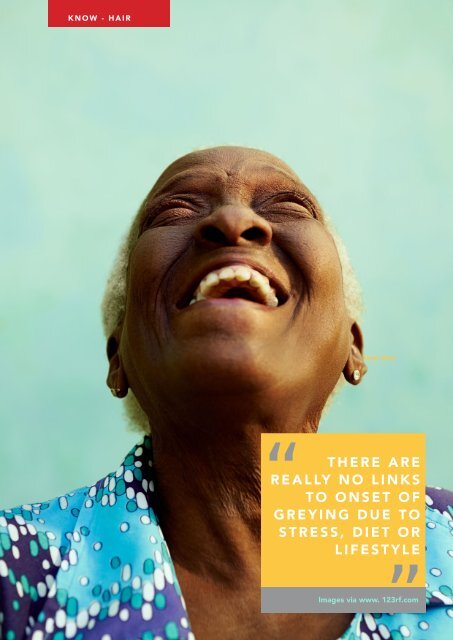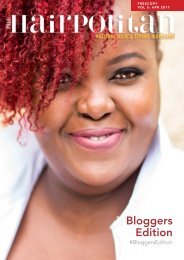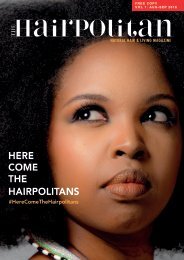THE HAIRPOLITAN MAGAZINE VOL 6 MAY 2017
Celebrating Mothers
Celebrating Mothers
You also want an ePaper? Increase the reach of your titles
YUMPU automatically turns print PDFs into web optimized ePapers that Google loves.
KNOW - HAIR<br />
Twist Outs<br />
“<br />
<strong>THE</strong>RE ARE<br />
REALLY NO LINKS<br />
TO ONSET OF<br />
GREYING DUE TO<br />
STRESS, DIET OR<br />
LIFESTYLE<br />
“<br />
Images via www. 123rf.com<br />
GREY IS <strong>THE</strong><br />
NEW BLACK<br />
by Evie Dondi<br />
You wake up one day, go through your daily morning<br />
routine and when you get to the part where you<br />
scrutinize yourself in the mirror, you freeze. You see<br />
a silver/grey hair – one hair and that’s it, your brain<br />
goes into a semi-panic state wondering, should you<br />
grab some tweezers and pluck it? Then you remember<br />
the grapevine information that states if you pull it,<br />
more will appear and that’s what you are avoiding.<br />
Then it dawns on you, but why? Why do you fear<br />
having greys/silvers? You are not alone. According<br />
to a survey by Crown Clinic, the UK’s leading hair<br />
transplant clinic, 72% of women dread the sight of<br />
their first grey hair.<br />
So what’s the science behind greying? It is as a result<br />
of the reduction of pigment and as you age. Chances<br />
of going grey increase anywhere from 10% - 20% every<br />
decade after you hit the 30year mark. Hair, believe it<br />
or not, is originally white and gets its pigment from<br />
melanin. There are two types of melanin responsible<br />
for the array of hair colors we see, dark (eumelanin)<br />
and light (phaeomelanin). Specialized pigment cells<br />
called melanocytes position themselves at the skin’s<br />
surface as the hair grows. During the formation of<br />
hair, these melanocytes inject melanin into the cells<br />
containing keratin. Keratin is known as the protein<br />
that makes up skin, hair and nails.<br />
The hair follicle has a melanogenic clock and as<br />
we age this clock slows or stops all together the<br />
melanocyte activity. This in turn reduces the amount<br />
of melanin that the hair receives, thus it turns<br />
grey. How soon the clock slows or stops is entirely<br />
controlled by age and genes, thus explaining the<br />
different rates at which we all grey. In 2009, scientists<br />
discovered that a slow build up hydrogen peroxide,<br />
produced by hair follicles, in the hair shaft, lead to<br />
a gradual loss of color. (FASEB Journal, v. 23, July<br />
2009: 2065-2075)<br />
We’ve all heard the saying ‘teenagers will give<br />
you grey hair’ but apparently there really no links<br />
to onset of greying due to stress, diet or lifestyle.<br />
However, an interesting factor that lends a hand to<br />
greying is race. In a survey of 4,000 people from<br />
around the world published in 2012 by the British<br />
Journal of Dermatology, 74% of those between the<br />
ages of 45-65 had grey hair. People of Asian and<br />
African American decent had less grey hair at any<br />
age than Caucasians.<br />
Lifestyle choice is another factor that speeds up<br />
greying of hair. According to a report in 2013 in the<br />
Indian Dermatology Journal, smokers are two and<br />
a half times more likely to start greying before the<br />
age of 30 than smokers. Looking for a reason to quit<br />
smoking? Well now you have it!<br />
The idea of women going grey/silver always receives<br />
mixed reactions and sometimes there’s a double<br />
standard. See, its ‘OK’ for men to grey early or rather<br />
gracefully and they even get sexy names such as the<br />
‘Salt & Pepper’ look. On the flip side, for women,<br />
there’s this social pressure to keep the hair colored<br />
as a sign of youth or vibrancy. Many women have<br />
reported feeling a need to keep looking youthful in<br />
order to maintain a successful career path. In any<br />
case it’s unfair. Additionally the hair market seems<br />
to subscribe to the same ageist agenda and dozens<br />
of hair dyes on the market are specifically made to<br />
cover up errant grey. However, the social pressure<br />
that befalls a woman who decides to let her hair do<br />
what it will naturally is slowly lifting and in fact grey<br />
is the new black.<br />
The new trend was first spotted on runways in 2014<br />
and is now spreading like wild fire across the globe.<br />
Grey has now gone from symbolizing aging to being<br />
a symbol of high fashion. This swap in representation<br />
has also lessened the stigma of aging and allowed<br />
older women to embrace the process. In the words<br />
of Erykah Badu, “Body and brain have aged. My<br />
consciousness has witnessed this, yet has not aged.<br />
This “awareness” is who we are.”<br />
32 33








